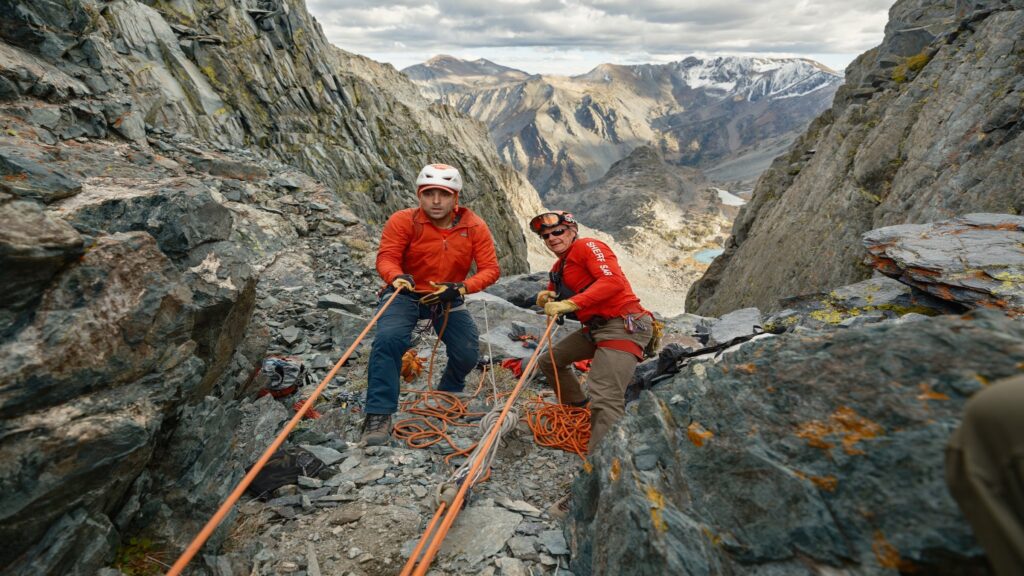Rescuers had to spend six hours erecting a rigging system to save the two, who were stuck on a sheer and rocky couloir deep in the Sierra Nevada
Rescuers found the two lost men by helicopter (Photo: Mono County Sheriff Search and Rescue Team)
Published October 13, 2025 03:49PM
Two backpackers were saved in dramatic fashion from a steep, icy cliff face in the California Sierra Nevada mountains, just north of Yosemite National Park. Emergency teams rescued the duo—who were not carrying a satellite messenger or an emergency beacon—after one of the hikers found a single bar of cell reception and called for help.
The incident occurred on the afternoon of October 7, atop Burro Lake Pass east of the Sierra Nevada mountain range, the Mono County Sheriff Search and Rescue Team said on Facebook.
A member of the responding rescue team told Outside that the two men were prepared for a casual day hike they had planned, but woefully unequipped for the trail they followed.
“These two guys in their twenties had been backpacking for a couple of nights out at Burro Lake,” Mono County Search and Rescue’s Mitchell Quiring told Outside.
Returning from an alpine lake, the pair took a different route from their hike in, ascending and descending the 11,300-foot Burro Lake Pass. After straying from their intended path, the duo became stranded after attempting to descend an extremely steep alpine couloir without climbing equipment.
“Instead of going up and over a completely clear shale and dirt pass, they ended up on top of this steep couloir, full of snow and ice,” Quiring explained.
Despite traveling without crampons, ice axes, ropes, helmets, and other technical equipment, the men did not turn back, and one attempted to pick his way down the narrow, 50-degree couloir, choked with ice and loose rock. One stranded himself on a snow ledge roughly 100 feet below the ridge crest, with another 800 feet of exposure below. He was unable to descend, but was also unable to climb back up to his partner.
“They didn’t have a satellite device, but one of them had one small bar of service on his phone, just enough to call for help,” Quiring said, adding that the reception on the call was so poor that the dispatchers weren’t able to communicate at length. “We tried calling, we tried texting, and the dispatchers were trying to get more information from them. But in the end, all we got was an initial: ‘I need help, I’m cliffed out.’”
By the time rescuers were deployed by helicopter to the pass and made contact with the stranded climber and his partner, they determined that any fall would be fatal.
“Had somebody slipped there and not been able to arrest their fall, it would have been a body recovery, not a rescue,” Quiring said.
What followed was a lengthy operation involving a dozen rescuers. Six, including Quiring, were operating from the top of the couloir, and six from below. The team employed a significant technical rigging system, first to drill into the rock to place anchors, and then to lower a rescuer down to the stranded climber from above and hoist him up to the top of the couloir, before assisting him into the waiting helicopter.
Both hikers were safely evacuated before sunset, and the operation concluded six hours after the initial emergency call. Both individuals experienced significant exposure to the elements, but denied further medical treatment.
Hope for the Best, Plan for the Worst
Quiring said the two hikers were adequately equipped for the casual hiking they had planned—had they stuck to the correct route—but were woefully underprepared for the technical terrain they encountered.
“They had no head protection, no harnesses, no bail cord, and no knowledge of how to conduct themselves in that kind of terrain,” he said.
Proper navigational equipment could have prevented the entire ordeal. Had the men been carrying even a paper map and familiarized themselves with their route beforehand, they likely could have avoided the situation.
What did the two men do right? Once they were in a dangerous situation, they called for rescue immediately before the situation worsened.
“They didn’t wait until nightfall; they didn’t waste time. The minute they knew they were in trouble, they called for help,” said Quiring, adding that the two were lucky. “It was a rare, windless Sierra day. The weather was incredibly compliant for rescue. If this had happened the day before, or the day after, the helicopter might not have been able to fly.”
The men were also fortunate enough to find a sliver of cell reception. Without an emergency SOS device or regular reception in the area, the pair may have had to resort to yelling (or blowing a whistle) to be heard.
There are a few lessons all backcountry travelers can take away from the incident.
“Have an understanding of where you’re going in the backcountry. Research your route thoroughly beforehand, and don’t enter terrain you’re not prepared for. Finally, plan for the unexpected. Carry a two-way satellite device. Give yourself the ability to call for help,” said Quiring.


